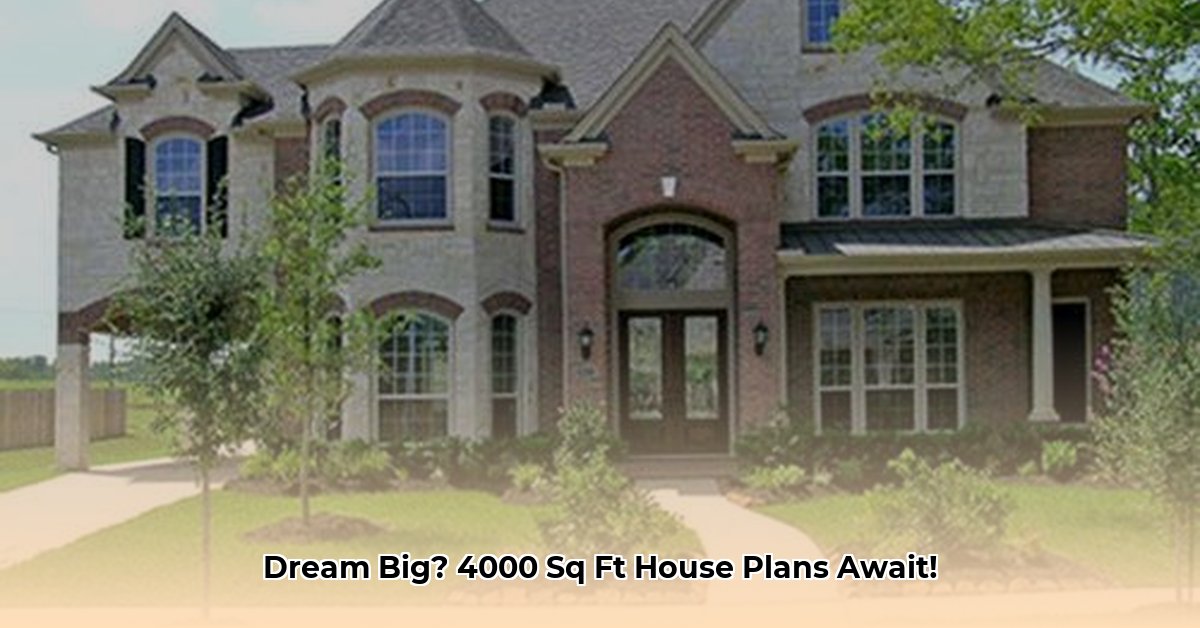Envisioning Your 4000 sq ft Dream Home
Dreaming of a home with space to breathe? A 4000 sq ft house offers a canvas for your vision. It’s not just about size; it’s about creating a comfortable, functional space that reflects your lifestyle. Imagine dedicated hobby areas, a productive home office, or a luxurious master suite. This size accommodates growing families, simplifies entertaining, and even allows for multi-generational living. But remember, larger homes come with added responsibilities like increased maintenance. Is this the right balance for you?
Defining 4000 Square Feet
What does 4000 sq ft feel like? It’s about volume and spaciousness. High ceilings, abundant natural light, and wide hallways create an airy ambiance. Envision a sprawling ranch, a majestic multi-story home, or a sleek modern design. A master suite could resemble a small apartment, while a gourmet kitchen boasts a spacious island and top-of-the-line appliances. A large living room accommodates gatherings, a separate dining room hosts dinner parties, and a family room offers casual comfort. Perhaps you’d include a home gym, game room, theater, library, or craft room. The possibilities are vast.
Consider your lifestyle. Do you entertain frequently? Have a large family? Work from home? An open-concept layout fosters togetherness, while separate areas offer privacy. Multiple bedrooms accommodate family and guests. A home office boosts productivity, and a large backyard becomes an outdoor oasis.
Architectural style shapes the feel and function. Explore Craftsman charm, Mediterranean elegance, traditional colonial grandeur, or contemporary minimalism. Remember, building a 4000 sq ft home is a significant financial undertaking. Costs depend on location, materials, finishes, and land prices. Don’t underestimate ongoing maintenance, including property taxes, insurance, and utilities. Consulting a financial advisor is wise. You’re not just building a house; you’re investing in a lifestyle.
Seek visual inspiration. Architectural magazines, online galleries, virtual tours, and model homes offer valuable insights. Seeing real-world examples helps solidify your vision. Ongoing research explores how people utilize large spaces, but firsthand experience is invaluable. This process might reveal unexpected considerations, leading to informed decisions.
Selecting Your Architectural Style
Choosing the right architectural style is crucial. It’s about expressing your personality and creating a home that reflects your lifestyle and budget. A sprawling ranch evokes family gatherings, while a sleek modern design suggests chic elegance.
Space Planning
Consider how you live. Do you prefer an open-plan layout or distinct rooms? A contemporary home might feature a seamless flow between kitchen and living room, while a Craftsman emphasizes cozy, defined spaces. A Mediterranean villa centers around courtyards, while a farmhouse prioritizes practicality and shared areas. Visualize your daily life: movie nights, holiday gatherings, and how each space should feel.
Lifestyle
Your home should be an extension of you. A bustling family might prefer a farmhouse design with flexible, practical spaces. A couple who entertains might opt for a modern design with open spaces and seamless indoor-outdoor flow.
Cost
Different styles have different price tags. An ornate Victorian costs more than a streamlined modern home. High-end materials impact the budget. Set a realistic budget early and choose a style that fits. Compromises might be necessary, but careful planning helps achieve your dream home affordably. Consider incorporating elements of a pricier style into a more budget-friendly design.
Maintenance
Consider long-term maintenance. Glass walls require frequent cleaning, while woodwork needs regular upkeep. Choose a style that aligns with your maintenance preferences.
Customization
A 4,000 sq ft house should cater to your specific needs. A skilled architect can personalize any style to include a home office, guest suite, or media room. They can blend seemingly disparate needs into a cohesive design.
Example Styles:
| Style | Pros | Cons | Considerations |
|---|---|---|---|
| Modern Farmhouse | Open layouts, rustic charm, indoor/outdoor living | Wood maintenance, potential noise/privacy challenges with open layouts | Suits families, entertaining, blends modern and traditional aesthetics. |
| Craftsman | Warmth, intricate details, craftsmanship | Potential darkness, higher building costs | Best for smaller families valuing traditional details. |
| Mediterranean | Indoor/outdoor flow, luxurious feel, connection to nature | High maintenance, climate-specific | Consider local climate and budget; may require specialized builders. |
| Contemporary | Clean lines, open spaces, flexible design, often eco-friendly | Can feel stark, may date quickly | Great for art lovers, entertainers, and modern design enthusiasts. |
Ongoing research introduces new materials and technologies. Consider sustainable building practices and smart home technology. Flexible floor plans adapt to changing needs. This information is a starting point. Consult architects and builders for informed decisions.
Locating and Assessing 4000 Sq Ft House Plans
Building a 4,000 sq ft home is about creating a personal haven. Let’s explore finding the perfect plan.
Architectural Style
Choosing a style is like expressing yourself through fashion. From sleek modern to cozy Craftsman, classic Colonial Revival to grand Mediterranean or rustic farmhouse, each style has unique character, influencing layout and materials. Browse design resources and visualize yourself in each style.
Layouts
Consider your lifestyle. Do you entertain? Need a home office? Prefer open-plan living or defined spaces? A well-designed floor plan creates seamless flow, maximizing space. Imagine separate wings for guests, a master suite, or a media room.
Cost Considerations
Dreaming big requires budget realism. Building costs vary significantly due to materials, location, and finishes. Get preliminary estimates from builders to stay within your financial comfort zone.
Evaluating Plans
Look beyond pretty pictures. Study floor plans for natural light, lifestyle suitability, and long-term needs. Consider energy efficiency, storage, and future modifications.
Customization
Most plans are customizable. An architect can personalize the design, adjusting room sizes and adding features to create a unique space.
Building Your Team
A skilled architect and reliable builder are essential. Interview multiple candidates, check references, and ensure comfortable communication.
Codes and Regulations
Building codes ensure safety. They vary by location and cover electrical, plumbing, and more. A knowledgeable builder navigates permitting, preventing headaches.
Example Styles and Considerations:
| Architectural Style | Characteristics | Potential Considerations |
|---|---|---|
| Modern Farmhouse | Clean lines, metal accents, open floor plans | Material specificity, noise/privacy with open layouts |
| Craftsman | Intricate details, exposed beams, natural materials | Higher cost due to craftsmanship |
| Mediterranean | Stucco, tile roofs, arched doorways, courtyards | Climate suitability, stucco/tile maintenance |
Ongoing research constantly evolves home design. Sustainable building practices and smart home technology are increasingly important. Flexible floor plans are gaining popularity. This information is a starting point; further exploration is encouraged.
Sarah Susanka, author of The Not So Big House, suggests focusing on how you truly live and designing spaces that reflect that, rather than simply filling a large footprint. This principle applies regardless of square footage.
This guide provides insights into designing your dream 4,000 sq ft home. Break it down step by step, considering your needs and priorities to create a beautiful and functional space.
- Dora the Explorer Wipe-Off Fun: Safe & Mess-Free Activities for Little Explorers - April 18, 2025
- Does Lemongrass Repel Mosquitoes? Fact vs. Fiction + How to Use It - April 18, 2025
- Do Woodchucks Climb Trees?Fact vs. Fiction - April 18, 2025










